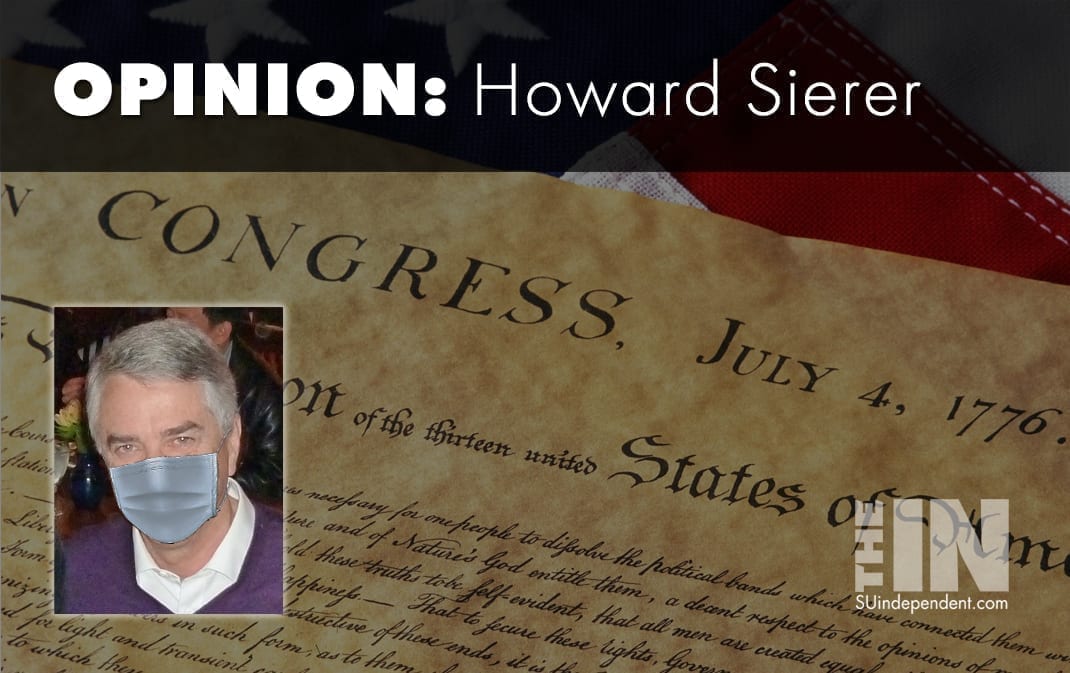
Revisiting Our Declaration of Independence
Most of us recognize the familiar image of the Declaration of Independence but few of us have read it in its entirety. A few famous phrases from Thomas Jefferson’s masterpiece will sound familiar, but join me in revisiting our Declaration of Independence.
The Declaration – “The unanimous Declaration of the thirteen united States of America” –mostly describes the rationale for independence: The actual declaration takes up only one paragraph at the end. But the Declaration’s timeless words have rung true through the ages.
“The truths of the Declaration of Independence are not limited by time or place,” John Quincy Adams wrote in 1839. “They belong to the nature of man in every age and every clime. They may be subdued, but they can never be suppressed. They are truths at Constantinople and Pekin, at London and Paris, at Charleston and at Philadelphia.”
The Declaration of Independence is divided into three distinct sections with the phrases that most of us remember coming in Jefferson’s opening paragraphs.
He made two bold statements that he called “self-evident.” In mathematics, such statements would be called axioms: a statement or proposition that doesn’t require proof.
The Declaration’s first axiom is “that all men are created equal.” The founders understood that human beings are different and unequal in many ways. But for political purposes, all men and women – regardless of race, religion, sex, or any other demographic cubby hole – are born equally free and independent and therefore should not be ruled by others without their consent.
The second self-evident truth is that human beings are “endowed by their Creator with certain unalienable rights.” Other documents of the founding era say that we possess these rights by birth or by nature. Today, we might say they are in our DNA.
Jefferson’s message is that no one gives us our fundamental rights: We possess them by virtue of being human. Governments may fail to secure them, criminals may violate them, but we are all entitled to “life, liberty and the pursuit of happiness.”
The Declaration emphasizes rights and not duties because its purpose is to affirm the rights of man against the claims of those in power. In Abraham Lincoln’s memorable words, it acts as “a rebuke and a stumbling-block to the very harbingers of re-appearing tyranny and oppression.”
If all men are created equal – if there is no natural right to political rule – then governments can only derive “their just Powers from the Consent of the Governed.” If we already possess our rights simply by being humans, then the task of government is not to give us rights, but “to secure these Rights.”
I’m reminded of our country’s other great foundational document, the Constitution. It begins, “We, the people” and proceeds to define what we give the government the right to do. Nowhere does it grant rights that we already possess.
The Declaration’s middle section is its largest, an indictment of King George III’s rule of the colonies. It lists 27 offenses that in aggregate justified separation from the mother country, ending with the statement that “A Prince, whose character is thus marked by every act which may define a Tyrant, is unfit to be the ruler of a free people.”
Following the middle section’s indictment, the final section declares “That these United Colonies are, and of Right ought to be Free and Independent States.”
This final paragraph also reminds us of the great personal risks shouldered by the signers. “And for the support of this Declaration, with a firm reliance on the protection of divine Providence, we mutually pledge to each other our Lives, our Fortunes, and our sacred Honor.”
While the Declaration was written over 200 years ago, its expansive language has inspired all seeking equality, liberty, and their “unalienable rights.”
Abolitionist Frederick Douglass in 1852 used words from the Declaration to call for racial justice and emancipation. He didn’t reject “the great principles it contains” or “the genius of American Institutions,” but instead recognized that it was the continuing applicability of the Declaration’s principles that gave it its power.
Abraham Lincoln stated that the Declaration “became not a justification of revolution, but a moral standard by which the day-to-day policies and practices of the nation could be judged.”
Harry Truman ended segregation in both the military and federal civil service in 1948. On the steps of the Lincoln memorial he said, “As Americans, we believe that every man should be free to live his life as he wishes. If this freedom is to be more than a dream, each man must be guaranteed equality of opportunity. When I say all Americans, I mean all Americans.”
The Declaration’s language calls for equality for all under the law, a government subordinate to the people, and a commitment to promoting liberty at home and abroad.
Both liberals and conservatives find inspiration in the Declaration’s principles but march off in different directions, liberals emphasizing equality while conservatives focus on individual liberty and limited government. Let’s save those differences for a different day. Instead, recognize how much we all owe to the wisdom and vision of our Founding Fathers.
Have a great Fourth of July and the rest of the summer!
Viewpoints and perspectives expressed throughout The Independent are those of the individual contributors. They do not necessarily reflect those held by the staff of The Independent or our advertising sponsors. Your comments, rebuttals, and contributions are welcome in accordance with our Terms of Service. Please be respectful and abide by our Community Rules. If you have privacy concerns you can view our Privacy Policy here. Thank you!
Click here to submit an article, guest opinion piece, or a Letter to the Editor




